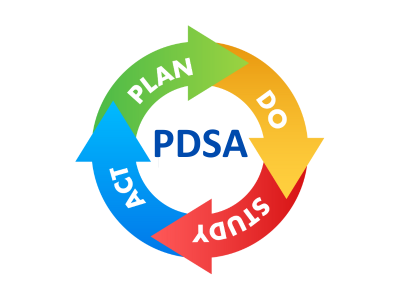
Plan-Do-Study-Act Cycle
Learning Objective: To understand what a plan-do-study-act cycle is and how it can be a useful tool for making improvements within your practice.
What is a PDSA cycle?
A Plan-Do-Study-Act (PDSA) cycle is an important tool in improvement science. PDSA cycles test changes on a small scale and use data to measure the effect of this change over time. This allows you to determine if the proposed change is an improvement or not. The PDSA cycle is wrapped around three questions (the Model for Improvement).
1. What are we trying to accomplish? (Aim statement)
2 . How do we know if change is an improvement? (Measures of success)
3 . What changes can we make that will result in improvement? (Changes being tested)
Why use PDSA?
PDSA cycles provide a structured, data-driven approach to managing change and can provide many benefits including:
-
Increased confidence that the chosen improvement will have the intended effect.
-
Understanding of how much improvement can be expected from each proposed change.
-
Observing unintended consequences of the change.
-
Resistors to change can feel more certain that the change will be successful.
-
Changes likely to ineffective are not implemented or are subsequently quickly replaced.
How to use the PDSA cycle
Plan – The change to be tested
- State the aim of the test.
- Make predictions about what will happen and why.
- Develop plan to test the change - Who? What? When? Where? What data needs to be collected?
Do – Carry out the test
- Try out the test on a small scale.
- Document problems and unexpected observations.
- Begin analysis of the data.
Study – Reflect on the impact of the change, using data.
- Set aside time to analyse the data and study the results.
- Complete the analysis of the data.
- Compare the data to your predictions.
- Summarise and reflect on what was learned.
Act – Decide on next course of action
Determine whether to adopt, adapt, or abandon.
- Adopt – full-scale implementation of change (PDSA can be used to manage this also).
- Adapt – make a modification and re-test using a new PDSA cycle.
- Abandon – abandon further cycles around this change idea.
Patients
In general, patients do not need to be aware of small test changes within the practice especially if they do not directly affect them.
Once an ‘Adopt’ decision is made for anything that affects how patients interact with the practice, patients should be notified and informed across multiple channels to ensure the message is received. When dealing with a large change it may be necessary to develop a plan on how you are going to communicate that change to patients.
Helpful Tips
PDSAs should start small in scale and build as confidence grows in using the tool.
Data should be tracked and presented over time. This is the simplest way to understand the impact of the change being tested.
PDSA cannot guarantee that you will deliver the desired improvement within your practice, but it will enable decisions to be made on the feasibility of the desired outcomes. This is a successful outcome of PDSA as it saves time that would have been wasted.
PDSA cycles do take time, but the time saved in the long run with a smooth and successful implementation of change is worth the effort required.
An example PDSA cycle can be found below.
Further Resources
We have created a PDSA template which can be found here.
Example PDSA
Project |
What are you trying to accomplish? |
|
|
As part of our Year 1 HCH implementation plan to better manage call demand we have implemented a call management system. Our data shows our average time to answer is 65 seconds. We aim to reduce that average to 30 seconds or below. |
Plan |
What question do you want to answer?How will you test your question (plan)?What data will you collect to measure if the change is an improvement? |
|
|
Question: How can we reduce our time to answer to 30 seconds or below? Plan: We plan to increase reception capacity during our busy periods. Data collected has shown that peak call times are between 8- 10 am daily. Additional reception FTE will be added during these peak times for 5 days. We predict this will significantly reduce time taken to answer incoming calls. Measure: During this 5-day trial our system will collect data on time to answer and compare this to previous data collections. |
Do |
Run the plan on a small scale, noting what you did. |
|
|
Additional reception FTE was added to increase capacity to manage phone call demand between 8 and 10 am every day. Anecdotal evidence from staff suggested the change had a positive impact, with staff feeling less pressure to quickly deal with patients. Our telephony system collected this data which is presented below. |
Study |
Record and analyse the results |
|
|
There was a significant (15 seconds) reduction in time to answer between the test and the original data collection. This suggests the change has had a positive affect at reducing the time to answer. |
Act |
Based on what you have learned, what are the next steps. |
|
|
We are planning to adopt this change and roster additional reception FTE for the busy period each day. We are still above our target of 30 seconds so further PDSA cycles will be carried out to test additional changes. |